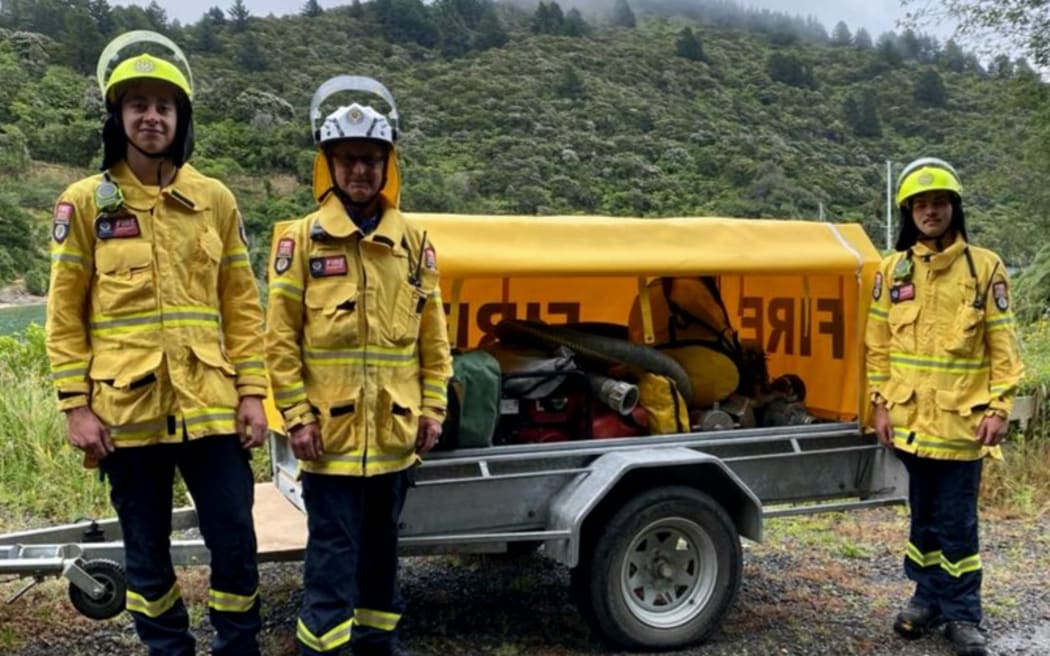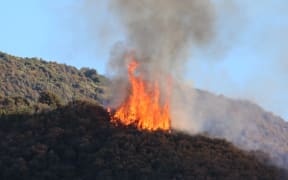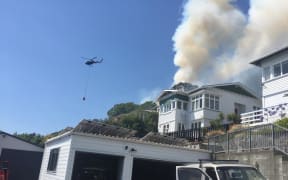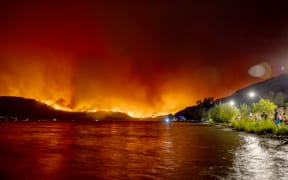
Sounds Rural Volunteer Fire Brigade members Tyst Hertoghs, fire chief Trevor Hook and Mika Boniface with one of the trailers used for fighting fires in the central Marlborough Sounds. Photo: Photo / Supplied
The central Marlborough Sounds is home to a team of rural firefighters who do not have a fire truck or even a station.
Instead, the Sounds Rural Volunteer Fire Brigade have a smoke chaser ute and trailers packed with firefighting gear, stored in containers around the network of sunken valleys at the top of the South Island.
Fire chief Trevor Hook owns Te Mahia Bay Resort in Kenepuru Sound and has been a volunteer firefighter in the area for nearly 30 years.
"We are different to any other brigade in the country in that we don't have a station, we have six different locations around the Sounds where we have fire gear and that is because of the isolation and the potential to get stuck on the road."
Each container houses a trailer loaded with firefighting gear, including water pumps, hoses, uniforms/personal protective equipment, first-aid gear and other equipment required to fight fires and respond to emergencies.
Hook said the rural firefighters were trained to provide the initial attack, protecting life first and then dwellings.
"That's our focus, to get there as fast as we can and to deploy as fast as we can to suppress the fire."
The sea is its biggest water source, with fires often fought from the coastline, using a series of water pumps.
The brigade has 29 active members, all volunteers, spread across the Kenepuru and surrounding areas, Mahau, Waitaria, Nopera and Hopai. Hook said they were expecting this summer to be drier than the last few years, bringing with it an increased fire risk.
He said visitors unaware of the fire risk and fires in baches were the biggest concerns for the brigade, as the weather began to heat up.
Marlborough is currently in a restricted fire season - which means outdoor fires are prohibited without a permit.
Brigade members were working proactively in the community to share fire safety messages and encouraging bach owners to ensure they had working smoke alarms and fire extinguishers installed.
Deputy fire chief Braden Moleta is a fourth-generation farmer in Titirangi Bay in the outer Sounds and has been part of the brigade for 10 years.
He said the Sounds had a history of wildfires, but the brigade had only responded to a handful in recent years, the last at Bell's Point in the Kenepuru Sound last July.
But the forecast El Niño meant that was likely to change.
Moleta said it was important people had defendable space around their properties and clear access for a fire truck if needed.
"People love to have their bach secluded and isolated with trees growing around it but they have to remember if we can't get to their house we can't help them and if they [have] vegetation like mānuka and kānuka which is extremely flammable, growing near the house, the chances aren't looking good to save that property if there is a wildfire going through."
During vegetation fires, the crew relied heavily on assistance from helicopters. Moleta is also an air support supervisor for FENZ, a role required when there are multiple aircraft to manage at the scene of a fire.
He leads training sessions for the crew every fortnight, with those who live furthest away travelling for close to one-and-a-half hours to attend.
The sessions include practise running pumps and hoses, using hand tools and simulating medical emergencies and motor vehicle accidents.
"It's a long haul and a lot to ask from our volunteers but there is a lot of dedication in the community.
"Everyone brings something different ... you've got farmers, tourism operators, IT specialists, an A&E nurse, a lot of life experience that adds to their role in the brigade."
Moleta said the crew had been lucky that the last few summers had not been too hot and dry, but this year was already looking much warmer.
Weather changes 'could catch people unaware'
NIWA says New Zealand is tracking to have one of its top three hottest years on record.
Scion fire and atmospheric team research scientist Hugh Wallace said the El Niño would bring slightly warmer and drier conditions.
"We might have a bit of a difference in the weather that we get on any given day, we might get more westerlies and they add up to catch people by surprise ... don't expect what you had before, it might not be this catastrophic 20 degrees Celsius warmer but what we are expecting is subtle differences that could catch people unaware."
That meant people should think carefully about whether it was appropriate to light a fire, engage in hot work or do anything that could spark a fire.
Unlike other parts of the world, Wallace said almost all fires in New Zealand were caused by human behaviour and even under extreme conditions, they were unlikely to happen on their own.
"How we choose to behave and what we choose to do when it's hot, dry, or windy has a huge effect on whether a fire starts.
"You do get freak accidents, but quite often it comes down to some planning ahead and putting water on a fire you have lit or choosing not to mow on that particular day."
Wallace said preparation before the fire risk increased, was key - removing any overhanging trees obstructing access, removing firewood stacked against a house and clearing out gutters.
It was something all residents should consider as the summer began to heat up.







